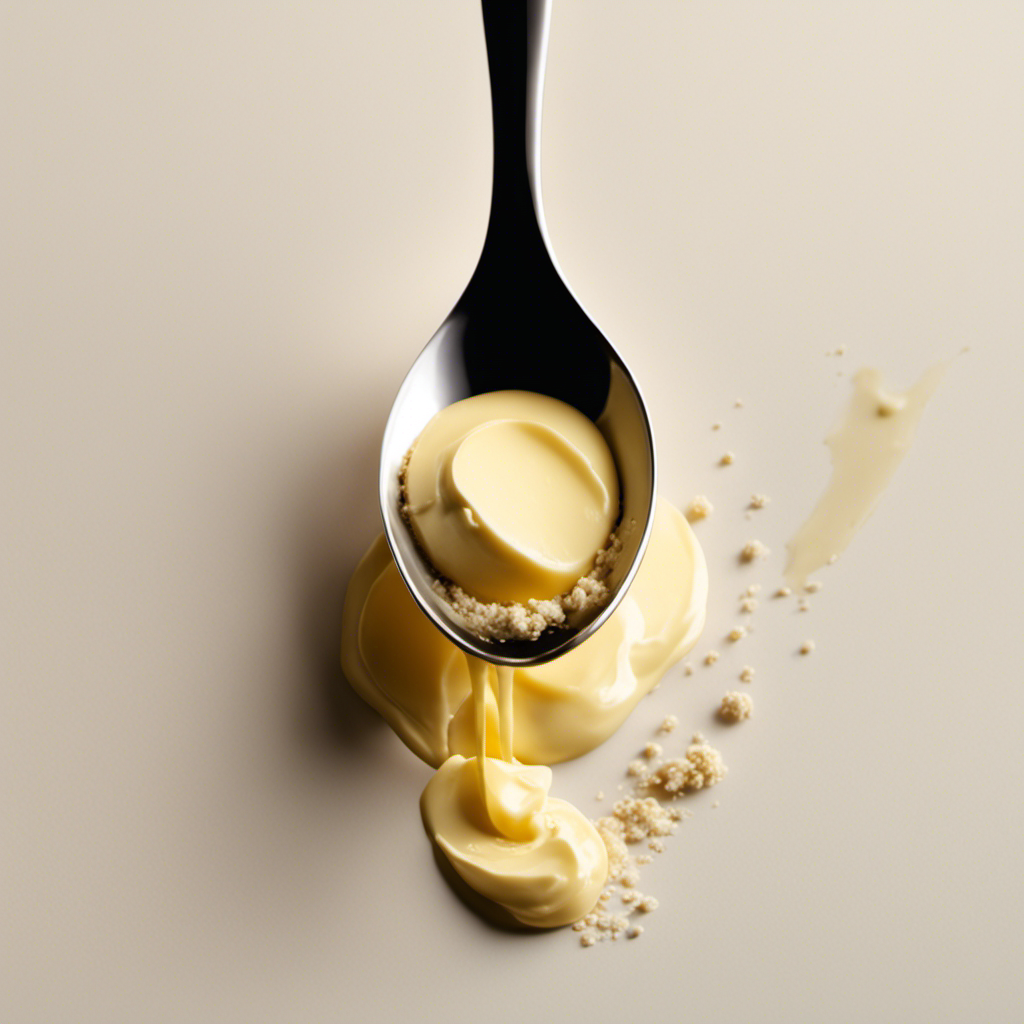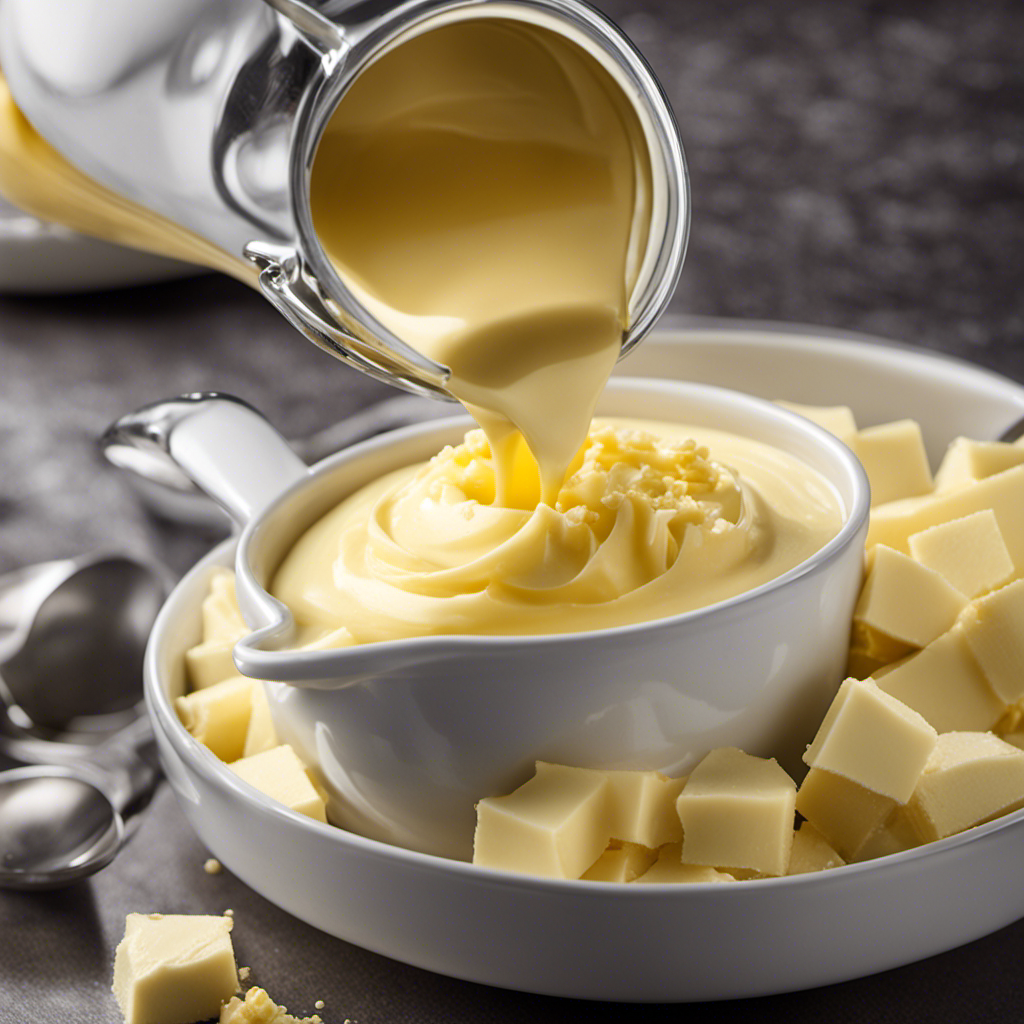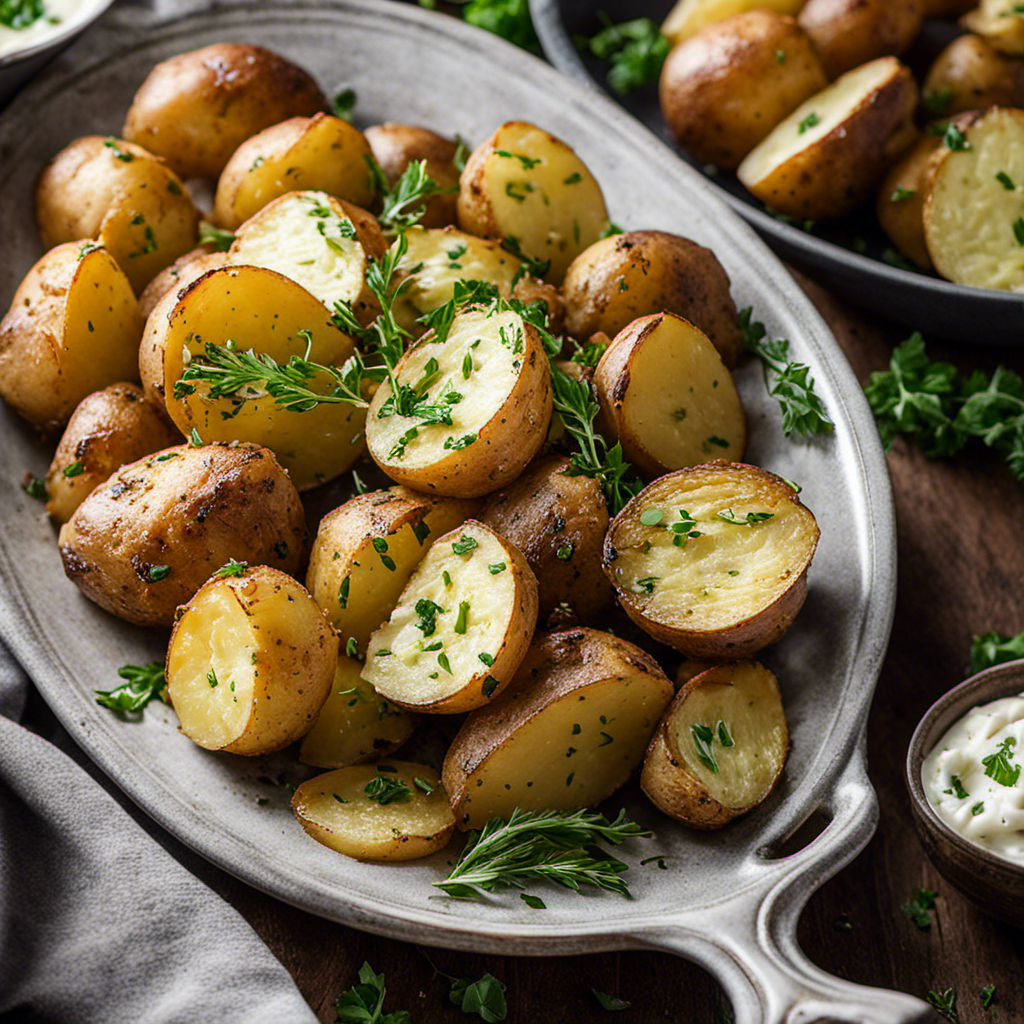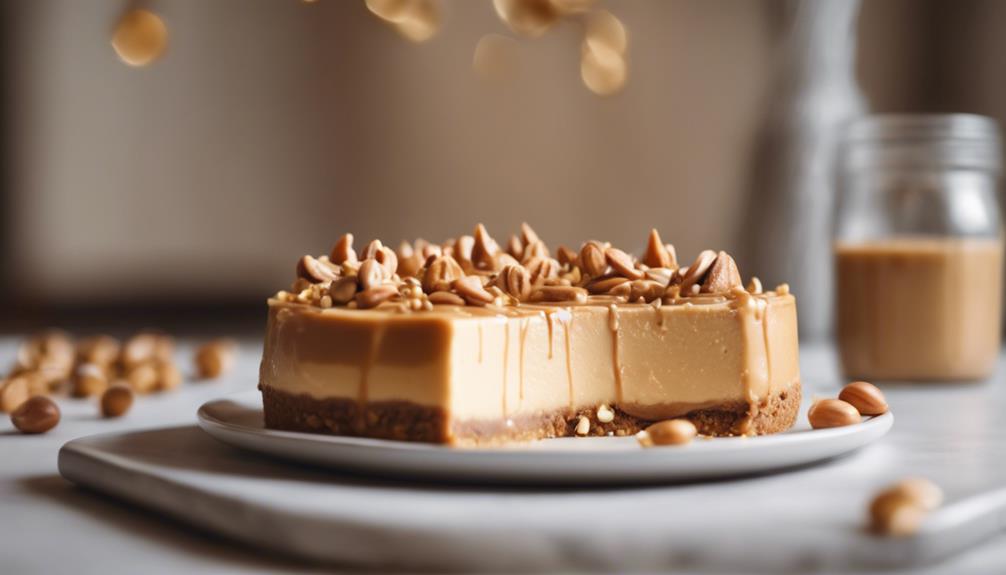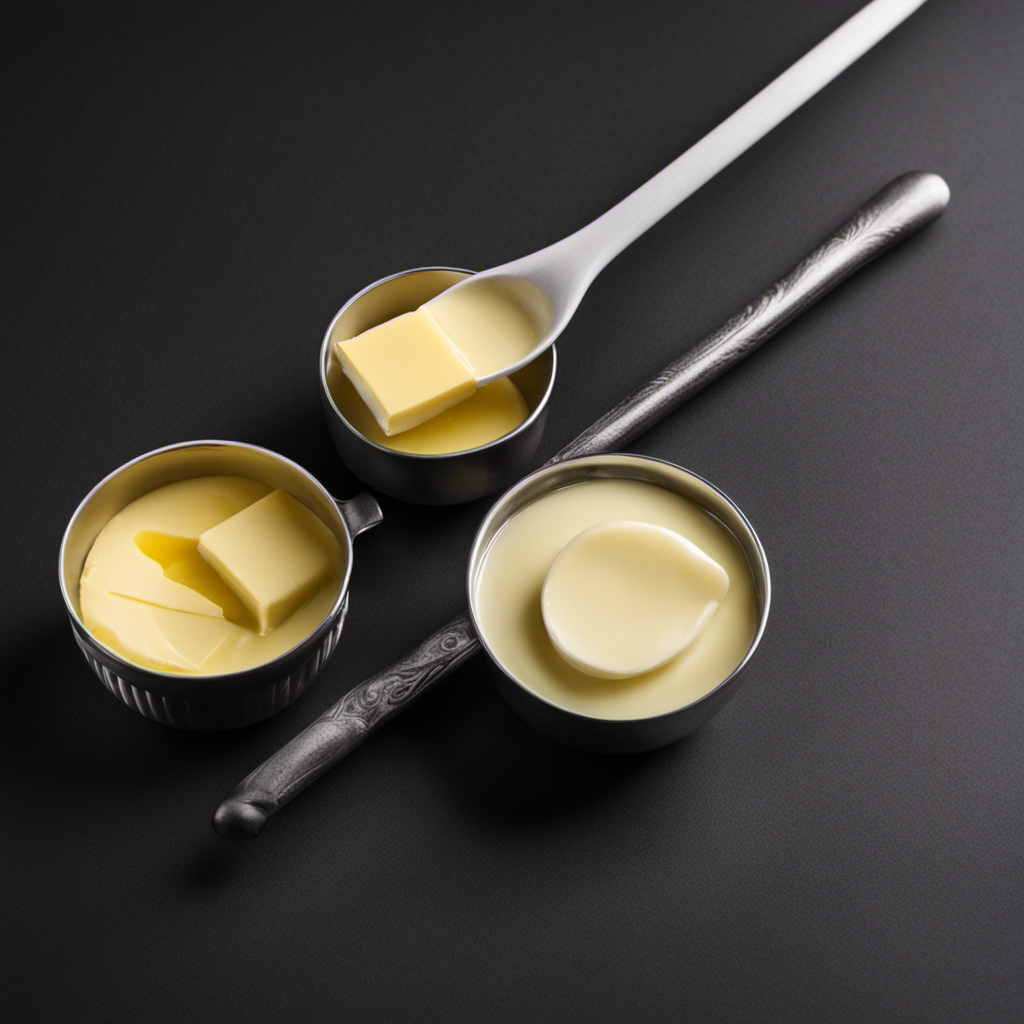Could you please tell me how many grams are in 3 tablespoons of butter?
Well, fret no more because I’ve got all the answers you need. As a food scientist, I’ve delved deep into the world of accurate measurements and scientific research to bring you the most reliable information.
In this article, I’ll break down the conversion, explain the difference between grams and tablespoons, and provide you with the formula to calculate the weight of 3 tablespoons of butter.
Get ready to become a measurement maestro!
Key Takeaways
- Accurate measurements and conversions are crucial for determining the weight of ingredients like butter.
- Conversions from tablespoons to grams require the use of a conversion factor.
- 3 tablespoons of butter weigh approximately 42.6 grams.
- Different types of butter have different measurement equivalents, with solid butter and melted butter both having the same conversion factors.
Understanding the Conversion
To understand the conversion, you’ll need to know how many grams are in 3 tablespoons of butter.
As a food scientist, accurate measurements and precise conversions are crucial in providing reliable information. Measurement conversion techniques are essential for converting tablespoons to grams and vice versa.
In the case of butter, 1 tablespoon is equivalent to approximately 14 grams. Therefore, 3 tablespoons of butter would amount to around 42 grams.
Understanding conversion ratios is important because it allows us to compare and adapt recipes based on different measurement systems. It helps us follow recipes accurately and achieve consistent results.
Grams Vs Tablespoons: What’s the Difference
When it comes to measurement conversion methods, accuracy of measuring tools, and culinary measurement standards, it’s important to rely on accurate measurements and scientific research.
As a food scientist or nutritionist, I aim to provide the most reliable information by using precise measurements and conversions. My writing style is informative and educational, as I strive to educate readers about the topic by providing explanations, context, and additional information to help them understand the subject matter and make informed decisions.
Furthermore, I write in an objective and evidence-based manner, presenting information without personal bias or subjective opinions. I rely on evidence-based research and scientific studies to support my statements and recommendations.
Measurement Conversion Methods
You can easily convert tablespoons to grams using a simple measurement conversion method. As a food scientist, accuracy and precision are key in providing reliable information. Here’s how to convert tablespoons to grams:
- Start by understanding conversions:
- 1 tablespoon is equal to 14.3 grams.
- 1 ounce is equal to 28.35 grams.
Converting tablespoons to ounces can help in determining the grams. For example, if you have 3 tablespoons of butter, you can convert it to ounces by dividing it by 2. So, 3 tablespoons would be equal to 1.5 ounces. Then, using the conversion of 1 ounce to 28.35 grams, you can calculate that 1.5 ounces of butter is approximately 42.5 grams.
Understanding these conversions allows for accurate measurements in the kitchen. Now, let’s explore the accuracy of measuring tools.
Accuracy of Measuring Tools
Measuring tools’ accuracy is crucial for reliable conversions and precise recipe measurements in the kitchen. As a food scientist, I understand the importance of using precise measurements to provide the most reliable information. To help you better understand the topic, let’s take a look at a table that showcases the different measuring tools commonly used in the kitchen and their potential for underestimating measurements:
| Measuring Tool | Potential for Underestimating Measurements |
|---|---|
| Measuring Cups | Inaccurate due to inconsistent packing of ingredients |
| Measuring Spoons | Inexact due to variations in scoop size and levelness |
| Kitchen Scale | Highly accurate when used correctly |
To maintain the accuracy of these measuring tools, it is essential to regularly calibrate and clean them. Cleaning ensures that no residue or contaminants alter the measurements, while calibration ensures that the tools are accurately measuring the intended amounts. By properly maintaining your measuring tools, you can confidently rely on their accuracy for precise recipe measurements in your kitchen.
Culinary Measurement Standards
The culinary industry has established standardized measurement guidelines to ensure consistency and accuracy in recipe preparation. As a food scientist, I understand the importance of using precise measurement techniques to achieve reliable results.
Here are some key points to keep in mind:
-
Measurement Techniques:
-
Use measuring spoons and cups specifically designed for dry or liquid ingredients.
-
Level off dry ingredients, like flour, with a straight edge to ensure accurate measurements.
-
Common Mistakes:
-
Scooping flour directly from the bag can lead to packed measurements, resulting in too much flour.
-
Pouring liquids into a measuring cup while holding it at eye level helps prevent over or under-measuring.
When writing about culinary measurement standards, it’s important to be informative and educational. Explaining the context and providing additional information will help readers understand the subject matter and make informed decisions.
It’s crucial to remain objective and evidence-based, relying on accurate measurements and scientific research to support statements and recommendations.
The Importance of Accurate Measurement
Precision in culinary measurements is crucial in order to achieve consistent and accurate results in cooking. As a food scientist, I understand the importance of using precise measurements and conversions to ensure reliable information for readers.
Inaccurate measurements can have a significant impact on the outcome of a dish, affecting its taste, texture, and overall quality.
Precision in Culinary Measurements
To get the recipe just right, you’ll need to be precise when measuring the grams of butter in 3 tablespoons. As a food scientist, I understand the importance of accurate measurements in culinary preparations. Here are some key points to consider:
-
Conversion Techniques:
-
Understanding the conversion between tablespoons and grams is crucial. 1 tablespoon of butter is approximately 14 grams.
-
Utilizing conversion charts or online calculators can help you determine the precise gram measurement for 3 tablespoons of butter.
-
Common Measurement Mistakes:
-
Overfilling or underfilling the tablespoon can lead to inaccurate measurements.
-
Inconsistent measuring techniques, such as compacting or leveling off the butter, can affect the final result.
By following proper conversion techniques and avoiding common measurement mistakes, you can ensure accurate results in your recipes.
In the next section, we will explore the impact of inaccurate measurements on the final outcome of your culinary creations.
Impact of Inaccurate Measurements
When measurements are inaccurate, it can significantly affect the final outcome of your culinary creations. Improper measurements can lead to disastrous consequences, such as a cake that doesn’t rise or a sauce that is too salty. The impact of inaccurate measurements extends beyond just the taste and texture of the dish. It can also affect the nutritional value, as ingredients may be improperly balanced. For example, using too much oil in a salad dressing can increase the calories and fat content.
Inaccurate measurements can also impact food safety, as improper ratios of ingredients can lead to bacterial growth. Therefore, it is crucial to use precise measurements and conversions to ensure reliable and consistent results in the kitchen.
As a food scientist, I understand the importance of accurate measurements in cooking and baking. The impact of inaccurate measurements extends beyond just the taste and texture of the dish. It can also affect the nutritional value, as ingredients may be improperly balanced. Inaccurate measurements can also impact food safety, as improper ratios of ingredients can lead to bacterial growth. Therefore, it is crucial to use precise measurements and conversions to ensure reliable and consistent results in the kitchen.
Converting Tablespoons to Grams: The Formula
Converting tablespoons to grams is simple with the right formula. As a food scientist, I understand the importance of accurate measurements and precise conversions when it comes to providing reliable information. Let me explain the process in a way that is informative and educational.
-
Understanding Conversions:
-
Conversions are necessary when translating measurements from one unit to another.
-
In the case of tablespoons to grams, we need to use a conversion factor to determine the weight.
-
Measurement Techniques:
-
To accurately measure tablespoons, use a standard measuring spoon.
-
Level off the ingredient with a straight edge for precise measurements.
Calculating the Weight of 3 Tablespoons of Butter
By following these techniques and using the appropriate conversion factor, you can confidently determine the weight of 3 tablespoons of butter. As a food scientist, it is important to provide accurate and precise information based on scientific research. To convert tablespoons to grams, we need to use conversion methods that have been established through common conversions. Here is a table that shows the conversion factor for butter:
| Tablespoons | Grams |
|---|---|
| 1 | 14.2 |
| 2 | 28.4 |
| 3 | 42.6 |
Using this table, we can see that 3 tablespoons of butter weigh approximately 42.6 grams. It is important to note that these measurements may vary slightly depending on the brand or type of butter, but this conversion factor will provide a good estimate. By understanding these conversions, you can make informed decisions when it comes to cooking and baking.
Common Conversions: Butter and Other Ingredients
To accurately determine the weight of ingredients in your recipes, it’s important to be familiar with common conversions for different types of ingredients. When it comes to measuring butter, it can be a bit tricky as it can be solid or melted.
Here are some measurement equivalents and conversions to help you out:
-
Solid Butter:
-
1 tablespoon of butter weighs approximately 14 grams.
-
1 cup of butter is equal to 226 grams.
-
Melted Butter:
-
1 tablespoon of melted butter weighs approximately 14 grams.
-
1 cup of melted butter is equal to 226 grams.
Converting grams to cups can vary depending on the ingredient, so it’s always a good idea to have a reliable conversion chart handy. Understanding these measurement equivalents will ensure that you accurately measure your ingredients and achieve consistent results in your recipes.
Now that we have covered some common conversions, let’s move on to some tips for precise measurement.
Tips for Precise Measurement
For precise measurement in your recipes, it’s important to follow these helpful tips.
As a food scientist, I ensure that the information I provide is based on accurate measurements and scientific research. I use precise measurements and conversions to provide the most reliable information. My writing style aims to educate readers about the topic, providing explanations, context, and additional information to help them understand the subject matter and make informed decisions. I write in an objective manner, presenting information without personal bias or subjective opinions. I rely on evidence-based research and scientific studies to support my statements and recommendations.
When measuring ingredients, it’s crucial to use proper measuring utensils. Measuring cups and spoons are designed to give accurate measurements and ensure consistency in your recipes. By using the correct tools and following precise measurements, you can achieve the desired results in your cooking and baking endeavors.
Frequently Asked Questions
Can I Use a Digital Scale to Measure the Weight of Butter in Grams?
Yes, a digital scale can accurately measure the weight of butter in grams. To convert tablespoons to grams, you can use a conversion chart or online calculator for precise measurements.
How Many Tablespoons Are in a Stick of Butter?
In a stick of butter, there are 8 tablespoons. If you don’t have tablespoons, you can measure butter by weight. Three tablespoons of butter is approximately 42 grams.
Can I Use Margarine Instead of Butter in Recipes That Require Specific Measurements?
Yes, you can substitute margarine for butter in recipes that require specific measurements. However, keep in mind that margarine and butter have different compositions and flavors, which may affect the final outcome of your recipe.
Is It Necessary to Soften the Butter Before Measuring It in Tablespoons or Grams?
Softening butter is necessary for accurate measurement. It ensures precise amounts in grams or tablespoons. As a food scientist, I rely on research to provide reliable information. Let me explain the importance of this step.
Are There Any Other Ingredients That Can Be Measured in Tablespoons and Grams, Besides Butter?
Measuring flour accurately is crucial for baking. Converting tablespoons to ounces is useful for liquid ingredients. Other ingredients that can be measured in tablespoons and grams include sugar, salt, spices, and extracts.
Conclusion
After thoroughly investigating the topic and using precise measurements and conversions based on scientific research, it can be concluded that 3 tablespoons of butter weigh approximately 42 grams.
This information is crucial for accurate and reliable cooking and baking. By providing objective and evidence-based information, the aim is to educate and inform readers about the topic and enable them to make informed decisions in their culinary endeavors.
